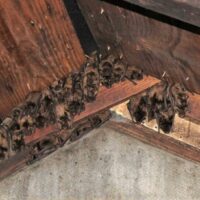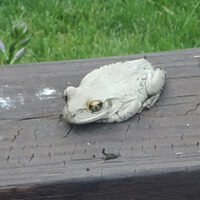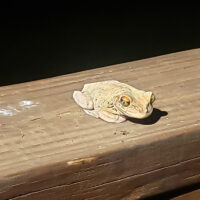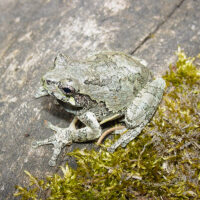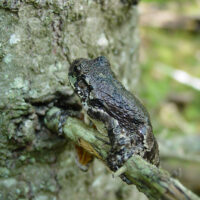 Purdue University - Extension - Forestry and Natural Resources
Purdue University - Extension - Forestry and Natural Resources
Got Nature? Blog
Purdue Landscape Report: Spotted lanternfly (SLF) has been the subject of a lot of media attention in the last few years. In the east, states like Pennsylvania and New York have been dealing with heavy infestations since the insect was first detected in 2014. In Indiana, this invasive planthopper arrived three years ago, infesting two counties on the eastern side of the state. Since then, the Indiana Department of Natural Resources and Purdue University have been working together to mitigate the spread of this insect as well as educate Hoosiers on what they can do to help. Spotted lanternfly is still on the move, and this update will help refresh you on how this bug works, and where they are headed.

Figure 1. Upper left: early-instar SLF; upper right: late-instar SLF; bottom left: adult SLF with egg mass; bottom right: uncovered SLF eggs.
Life cycle
Spotted lanternfly is an annual insect, having only a single generation in a year under normal conditions. The insect goes through incomplete metamorphosis; immature stages, called nymphs, resemble smaller, wingless versions of the adults. Nymphs will begin to appear in April or May, developing through four instars, until they reach adulthood in late summer. With each instar, the period in between molting, the nymph will grow larger, develop wingpads, and eventually change color. Early instars are black with a white dot pattern, while later instars will be bright red with black and white patterning (Fig. 1). Late instar nymphs are often compared to milkweed bugs or lady beetles. Once they complete development in the late summer or early fall, they will mate and lay egg masses covered in a protective substance that makes them resemble mud. Eggs masses will overwinter until the spring, while adult insects will die as temperatures cool. In Indiana, depending on temperature, adults can be seen as late as early November.
Impact
Spotted lanternfly is a sap-feeding insect, using syringe-like mouthparts to drain nutrients directly from plant tissues. Like other sap-feeding insects, the activity of SLF wounds the plant, creating openings for various pathogens to exploit. Feeding by SLF has been shown to reduce overall health of their hosts, reducing their capacity to survive overwintering, and potentially kill the host plant depending on species. They also produce a sugary waste known as honeydew; while honeydew itself is not harmful, it acts as a growing substrate for sooty mold, which can have a serious impact the photosynthesis of understory foliage as well as attract other nuisance insects.
Spotted lanternfly is a generalist herbivore and can feed on over 100 different species of plant and tree in Indiana. However, this insect has shown strong preference towards certain species, often with devastating consequences. The most preferred host is tree-of-heaven, an invasive tree species in North America. Tree-of-heaven is the primary host of SLF in their shared native range, and the insect appears to experience high reproductive success on it even when they share a new environment. Grapes are also highly preferred by SLF, and infestations will typically result in overfeeding and the death of the plant. Black Walnut, American river birch, and various maple species are also at risk of severe damage from this insect. Evidence has also suggested that maple, when used for syrup production, will experience reductions in yield and quality when attack by spotted lanternfly.
Where are they now?
Spotted lanternfly has been present in Indiana since 2021, first arriving in Huntington and Switzerland Counties. In Huntington, the infestation occupies a stand of tree-of-heaven next to an industrial parking lot. Tree-of-heaven moved into the neighboring residential area, allowing SLF to also spread with it. The more rural infestation in Switzerland County was traced to a vehicle transported from Pennsylvania, and the insect has taken advantage of patches of tree-of-heaven in nearby wooded areas. While both infestations have strongly associated with the insect’s primary host, there is some evidence that SLF is beginning to take advantage of other nearby plants, such as maple. In the last year, SLF moved a significant distance and has been detected in several more counties, including Elkhart, St. Joseph, Porter, Allen, Dekalb, and Noble Counties. Most of the activity has been found on tree-of-heaven along rail lines, supporting the idea that the insect is dispersed by rail traffic moving westward out of infested areas.
It’s important to remember that trains aren’t the only vehicles that can have SLF passengers. These insects, and their egg masses, can be found on just about any surface, including the car you drive to work, the RV you used for recreation, semi-trucks that cross the country, and more. Purdue Entomology and Indiana DNR are encouraging everyone to inspect their vehicles when traveling through any of the infested areas. Also check all recreational vehicles and trailers for spotted lanternfly egg masses; if found, scrape them off into a bag or bucket filled with soapy water. This fall and winter, we also want to encourage everyone to please burn any firewood where you buy it, and please don’t move it off your property if you chop it yourself- especially if you are burning tree of heaven. Egg masses will stick to firewood and can survive our winters very well.
What can I do?
We are still learning about the spotted lanternfly’s distribution through Indiana, and we need the help of citizen scientists to effectively track the insect’s movement. If you believe you’ve seen spotted lanternfly, please report it using any of the resources listed below. You can also feel free to reach out to Bob Bruner, Exotic Forest Pest Educator, by emailing them at rfbruner@purdue.edu, or you can report sightings by calling 1-866-NOEXOTIC. Keep an eye out, and have a great time at state fair!
Original article posted: Spotted Lanternfly is on the Move!.
Subscribe and receive the newsletter: Purdue Landscape Report Newsletter.
Resources:
The Purdue Landscape Report
Spotted Lanternfly, Indiana Department of Natural Resources Entomology
Spotted Lanternfly Found in Indiana, Purdue Landscape Report
Invasive plants: impact on environment and people, The Education Store, Purdue Extension’s resource center
Woodland Management Moment: Invasive Species Control Process, Video, Purdue Extension – Forestry and Natural Resources (FNR) YouTube Channel
Invasive Species, Playlist, Purdue Extension – FNR YouTube Channel
What are invasive species and why should I care?, Got Nature? Blog, Purdue Extension – FNR
Report Invasive, Purdue College of Agriculture – Entomology
Pest Management, The Education Store
Bob Bruner, Exotic Forest Pest Educator
Purdue Entomology
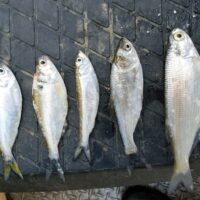
Fish from left to right: Threadfin Shad, Gizzard Shad, Skipjack Herring, Silver Carp (invasive carp), and Goldeye.
Wild Bulletin, Indiana Department of Natural Resources (DNR) Fish and Wildlife: Spring is the time anglers return to fishing on Indiana’s lakes and rivers. Often that includes catching and using live bait. Remember to dispose of all unused bait fish properly in the trash, as invasive carp could be lurking in your bait bucket. Improperly disposing of unused bait fish in a lake or stream could potentially allow invasive species, like silver carp, to spread in Indiana waters.
Invasive carp are a select group of cyprinid fishes (minnow family) that are native to Asia. The term “invasive carp,” formerly known as “Asian carp,” collectively refers to bighead carp, silver carp, grass carp, and black carp. Each of these species was intentionally introduced into the United States for different purposes; however, all are now considered invasive nationally and in Indiana. Invasive carp compete with native species and pose a threat to Indiana’s aquatic ecosystems.
Find out more about how you can help in the fight against invasive carp at DNR: Fish & Wildlife Resources.
Resources:
Asian Carp | Purdue University Report Invasive Species
Question: Aren’t There Concerns About Consuming Asian Carp As A Food Source In Indiana Streams?
Invasive Species, Playlist, Purdue Extension – FNR YouTube Channel
What are invasive species and why should I care?, Got Nature? Blog, Purdue Extension – Forestry and Natural Resources
Report Invasive Species, Purdue Invasive Species
Walleye Farmed Fish Fact Sheet, The Education Store, Purdue Extension’s resource center
Yellow Perch Farmed Fish Fact Sheet, The Education Store
A Guide to Small-Scale Fish Processing Using Local Kitchen Facilities, The Education Store
Eat Midwest Fish, Illinois-Indiana Sea Grant online resource hub
Indiana Department of Natural Resources
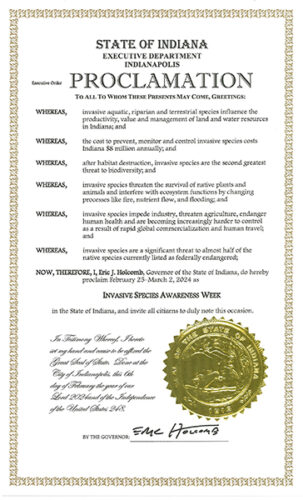 Governor Eric Holcomb has proclaimed February 25th to March 2nd as 2024 Invasive Species Awareness Week in Indiana.
Governor Eric Holcomb has proclaimed February 25th to March 2nd as 2024 Invasive Species Awareness Week in Indiana.
This serves as an important reminder for Hoosiers to be aware and report potentially devastating invasives.
This proclamation states “invasive aquatic, riparian and terrestrial species influence the productivity, value and management of land and water resources in Indiana and the cost to prevent, monitor and control invasive species costs Indiana millions annually and after habitat destruction, invasive species are a great threat to biodiversity and threaten the survival of native plants and animals and interfere with ecosystem functions by changing processes like fire, nutrient flow and flooding”.
It continues with “invasive species impede industry, threaten agriculture, endanger human health and are becoming increasingly harder to control as a result of rapid global commercialization and human travel; and invasive species are as significant threat to almost half of the native species currently listed as federally endangered.”
As Invasive Species Awareness Week starts Sunday, February 25th, the Indiana Department of Natural Resources (IN DNR), Purdue Extension-Forestry and Natural Resources and the Indiana Invasive Species Council will answer any questions you may have.
For Questions:
Ask an Expert, Purdue Extension-Forestry and Natural Resources
Invasive Species – Indiana Department of Natural Resources (IDNR)
Indiana Invasive Species Council – Includes: IDNR, Purdue Department of Entomology and Professional Partners
Cooperative Invasive Species Management Area (CISMA)
Report and Learn More About Invasive Species –
Great Lakes Early Detection Network App (GLEDN) – The Center for Invasive Species & Ecosystem Health
EDDMaps – Early Detection and Distribution Mapping System
Purdue University Report Invasive Species, College of Agriculture
Check Out Our Invasive Species Videos –
Subscribe: Purdue Extension-Forestry and Natural Resources (FNR) YouTube Channel
Invasive Species YouTube Video Playlist includes:
- Asian Bush Honeysuckle
- Burning Bush
- Callery Pear
- Multiflora Rose
- Invasive Plants Threaten Our Forests Part 1: Invasive Plant Species Identification
- Invasive Plants Threaten Our Forests Part 2: Control and Management
More Purdue Extension-FNR YouTube Video Series –
Woodland Management Moment:
Woodland Stewardship for Landowners:
ID That Tree:
More Resources –
FNR Extension Publications, The Education Store:
- Invasive Plant Species: Tree of Heaven
- Invasive Plant Species: Oriental Bittersweet
- Invasive Plant Species: Wintercreeper
- Japanese Chaff Flower
- Kudzu in Indiana
- Mile-a-minute Vine
Purdue Landscape Report:
FNR Extension Got Nature? Blog:
Don’t Miss These Resources:
Episode 11 – Exploring the challenges of Invasive Species, Habitat University-Natural Resource University
What Are Invasive Species and Why Should I Care?, Purdue Extension-FNR Got Nature? Blog
Emerald Ash Borer Information Network, Purdue University and Partners
Aquatic Invasive Species, Illinois-Indiana Sea Grant (IISG)
Invasive plants: impact on environment and people, The Education Store, Purdue Extension’s resource center
Purdue Extension-Forestry and Natural Resources
Wild Bulletin, Indiana Department of Natural Resources (DNR) Fish and Wildlife: Indiana DNR has been working with neighboring states to address the invasive carp problem in our waters. The Kentucky Department of Fish and Wildlife Resources has been using contract fishers to harvest invasive carp from the middle Ohio River at the leading edge of invasive carp’s established population, and the Indiana Division of Fish & Wildlife provides support as needed. The contract fishing program will be operating through the winter and spring. Most fishing will occur from Leavenworth to Cannelton, Indiana, in small tributaries and backwaters off the Ohio River. Agency staff will ride along with contract fishers to collect data and ensure native fish populations are not negatively impacted.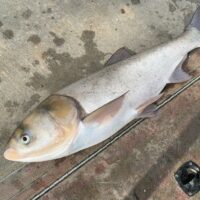
Throughout the year, biologists are involved in several other collaborative research and monitoring projects to slow the spread of invasive carp within the Ohio River basin. If you encounter an invasive carp and are wondering what to do with it, try eating it! Our website includes information on how to clean and prepare silver carp for a tasty meal, as well as descriptions of other DNR projects that address invasive carp.
To learn more please visit DNR: Invasive Carp.
Resources:
Asian carp solutions: Take them to market, Illinois-Indiana Sea Grant
Asian carp, Illinois-Indiana Sea Grant
Asian carp, Purdue College of Agriculture
Invasive Species, Playlist, Purdue Extension – FNR YouTube Channel
What are invasive species and why should I care?, Got Nature? Blog, Purdue Extension – Forestry and Natural Resources
Report Invasive Species, Purdue Invasive Species
Walleye Farmed Fish Fact Sheet, The Education Store, Purdue Extension’s resource center
Pacific White Shrimp Farmed Fact Sheet, The Education Store
Yellow Perch Farmed Fish Fact Sheet, The Education Store
Tilapia Farmed Fish Fact Sheet, The Education Store
Rainbow Trout Farmed Fish Fact Sheet, The Education Store
American Paddlefish, The Education Store
A Guide to Small-Scale Fish Processing Using Local Kitchen Facilities, The Education Store
Eat Midwest Fish, Illinois-Indiana Sea Grant online resource hub
Indiana Department of Natural Resources
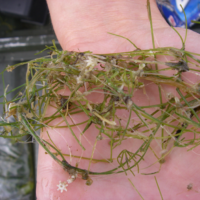 MyDNR, Indiana’s Outdoor Newsletter: Did you know that Indiana’s waterways can be altered by the presence of aquatic invasive species? Non-native plants, animals, and organisms can disrupt bodies of water and ecosystems, threatening sport fisheries and other commercial resources.
MyDNR, Indiana’s Outdoor Newsletter: Did you know that Indiana’s waterways can be altered by the presence of aquatic invasive species? Non-native plants, animals, and organisms can disrupt bodies of water and ecosystems, threatening sport fisheries and other commercial resources.
If you’re wondering what you can do to help prevent the spread of aquatic invasive species, there are many easy steps that Hoosiers and out-of-state visitors can take to stop aquatic hitchhikers:
- Clean off any animals, plants, and mud from any angling or boating gear.
- Drain the water from watercrafts, bladder tanks, bilges, motors, livewells, and portable bait containers before leaving the water access area.
- Make sure everything air-dries for five days or longer or is dried with a towel.
- Dispose of any unwanted or unused bait, fish parts, and packing materials in the trash, rather than on the ground or in water. Remember, littering harms the environment.
DNR is counting on you to help protect Indiana’s waterways and species.
Newsletter can be found online: MyDNR Email Newsletter
For more information please visit DNR: Fish & Wildlife: Aquatic Invasive Species (AIS).
Resources:
Invasive Mussels, IN DNR Fish and Wildlife
Aquatic Invasive Species in the Great Lakes: The Quagga Mussel, Purdue Extension – Forestry & Natural Resources (FNR) Got Nature? Blog
Aquatic Invaders in the Marketplace, Illinois-Indiana Sea Grant (IISG)
Invasive Species, Playlist, Purdue Extension – FNR YouTube Channel
What are invasive species and why should I care?, Got Nature? Blog, Purdue Extension – Forestry and Natural Resources
Report Invasive Species, Purdue Invasive Species
The GLEDN Phone App – Great Lakes Early Detection Network
EDDMaps – Early Detection and Distribution Mapping System
Indiana Department of Natural Resources: Invasive Species
Indiana Invasive Species Council
Cooperative Invasive Species Management Area (CISMA)
Great Lakes Sea Grant Network (GLERL), NOAA – Great Lakes Environmental Research Laboratory
A Field Guide to Fish Invaders of the Great Lake Regions, Illinois-Indiana Sea Grant (IISG)
Purdue Researchers Get to the Bottom of Another Quagga Mussel Impact, Illinois-Indiana Sea Grant (IISG)
Invasive plants: Impact on Environment and People, The Education Store, Purdue Extension’s resource center
Protect Your Waters, U.S. Fish and Wildlife Service & U.S. Coast Guard
Nongame and Endangered Wildlife, Indiana Department of Natural Resources
Indiana Department of Natural Resources, Department of Fish & Wildlife
MyDNR, Indiana’s Outdoor Newsletter: Do you have bats roosting on your property? Help DNR by counting how many bats fly out during a few evenings this summer. Monitoring bats as they emerge from roosts helps us manage the reproductive health of bats across the state.
The Summer Bat Roost Monitoring Project uses volunteers to collect information on the distribution, occupancy and abundance of bat colonies throughout Indiana.
Participants must have bats roosting on their property or permission to enter property where a roost occurs. Possible roost sites include trees, bat houses, barns, attics, outbuildings and other structures. On each night of surveying, volunteers count the bats that exit the roost and record weather information. Each survey takes about an hour and is conducted on eight to 12 nights from mid-May to mid-July.
Newsletter can be found online May: DNR: Communications: MyDNR Email Newsletter (in.gov)
For more information please visit Summer Bat Roost Monitoring Project.
To sign up for the project, visit the Division of Fish & Wildlife’s volunteer page and select “Find an ongoing service project.” Wildlife Diversity staff also monitor bats using mobile acoustic surveys and acoustic monitoring stations.
Resources:
Hardwood Ecosystem Experiment (HEE) Highlights: Bats, Video, Purdue Extension – Forestry and Natural Resources (FNR) YouTube Channel
Bats in the Belfry, Purdue Extension – FNR Got Nature? Blog
Ask An Expert: Bats on the Hardwood Ecosystem Experiment (HEE), Video, Purdue Extension – FNR Facebook
Bats in Indiana, Indiana Department of Natural Resources (IN DNR)
Bat Houses, Bat Conservation International
Creating a Wildlife Habitat Management Plan for Landowners, The Education Store, Purdue Extension’s resource center
The Hardwood Ecosystem Experiment (HEE): Indiana Forestry and Wildlife, The Education Store
Subscribe to Purdue Extension-FNR YouTube Channel
Indiana Department of Natural Resources, Department of Fish & Wildlife
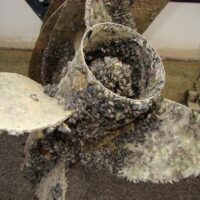 Wild Bulletin, Indiana DNR Fish & Wildlife email newsletter, Help stop the spread of aquatic invasive species: DNR and several Indiana conservation organizations gathered to take part in the fourth annual Great Lakes Aquatic Invasive Species Landing Blitz from June 24th to July 10th. Staff and volunteers were at state parks helping boaters, anglers and other water enthusiasts check their watercraft and other equipment for aquatic invasive species, along with educating them on preventive measures.
Wild Bulletin, Indiana DNR Fish & Wildlife email newsletter, Help stop the spread of aquatic invasive species: DNR and several Indiana conservation organizations gathered to take part in the fourth annual Great Lakes Aquatic Invasive Species Landing Blitz from June 24th to July 10th. Staff and volunteers were at state parks helping boaters, anglers and other water enthusiasts check their watercraft and other equipment for aquatic invasive species, along with educating them on preventive measures.
Aquatic invasive species are plants, animals, and other organisms that are not native to Indiana waters and have the potential to cause harm. These species are concerning because they outcompete native species, threaten human health, change and degrade the ecosystem, and/or require intense maintenance and monitoring.
Most invasive species find their way to Indiana through human behaviors. Modern transportation brings goods including invasive species from all around the world in a matter of hours or days. Some exotic pets or plants used in aquariums or water gardens escape into the wild and if they are adapted to Indiana’s conditions, they can become invasive. Boats and ships moving from waterbody to waterbody can spread invasives. Some invasives were brought to the U.S. intentionally as bio-controls for other invasives; others were introduced as game or food species.
Invasive species can be very expensive or impossible to control. For instance, Indiana spends an estimated $1 million per year in public waters to chemically control Eurasian watermilfoil, an invasive water plant that can shade out native species and interferes with boating and fishing. The damage to sport fisheries and commercial resources from AIS can be serious.
To learn how to stop “hitchhikers” and to learn more about aquatic invasive species view IN DNR: Aquatic Invasive Species.
Resources:
Invasive Mussels, IN DNR Fish and Wildlife
Aquatic Invasive Species in the Great Lakes: The Quagga Mussel, Purdue Extension – Forestry & Natural Resources (FNR) Got Nature? Blog
Aquatic Invaders in the Marketplace, Illinois-Indiana Sea Grant (IISG)
Invasive Species, Playlist, Purdue Extension – FNR YouTube Channel
What are invasive species and why should I care?, Got Nature? Blog, Purdue Extension – Forestry and Natural Resources
Report Invasive Species, Purdue Invasive Species
The GLEDN Phone App – Great Lakes Early Detection Network
EDDMaps – Early Detection and Distribution Mapping System
Indiana Department of Natural Resources: Invasive Species
Indiana Invasive Species Council
Cooperative Invasive Species Management Area (CISMA)
Great Lakes Sea Grant Network (GLERL), NOAA – Great Lakes Environmental Research Laboratory
A Field Guide to Fish Invaders of the Great Lake Regions, Illinois-Indiana Sea Grant (IISG)
Purdue Researchers Get to the Bottom of Another Quagga Mussel Impact, Illinois-Indiana Sea Grant (IISG)
Invasive plants: Impact on Environment and People, The Education Store, Purdue Extension’s resource center
Protect Your Waters, U.S. Fish and Wildlife Service & U.S. Coast Guard
Nongame and Endangered Wildlife, Indiana Department of Natural Resources
Indiana Department of Natural Resources (IN DNR) – Fish and Wildlife
Illinois-Indiana Sea Grant Newsroom: Many Great Lakes communities that have carried the burden of legacy pollution for decades have an opportunity for a new lease on life when local waterways are finally cleaned up. A new video series features five cities along waterways deemed Areas of Concern (AOCs) that are in various stages of the cleanup process and are experiencing revitalization.
Historically, the Great Lakes region was a center of industry—steel, leather and lumber, to name a few—that eventually shut down or moved elsewhere as economies and priorities changed. Left behind in these waters was a soup of contamination, leaving degraded waterways and depressed communities.
In the United States and Canada, dozens of sites were identified as AOCs in the Great Lakes Water Quality Agreement, and over the years, many have undergone remediation.
The U.S. EPA Great Lakes National Program Office (GLNPO) has provided leadership throughout the cleanup process, which involves dredging or capping contaminated sediment. Even before the cleanup and subsequent restoration, local agencies and organizations have a seat at the table to discuss processes and priorities.
Funding is often a partnership between the federal government, in the form of the Great Lakes Legacy Act (now through the Great Lakes Restoration Initiative), and state, regional and local stakeholders.
The videos feature five cities—Duluth, Minnesota; Muskegon, Michigan; Sheboygan, Wisconsin; Ashtabula, Ohio; and Buffalo, New York—that have had some or all of their contaminated sites cleaned up and ecosystems restored. Local government representatives, business owners and residents share the impact of this work on recreation, tourism, economic development, housing and quality of life in the area.
For full article and videos > > >
About IISG: These are trying times for the environment. Climate change and other concerns such as population growth, aquatic invasive species, contaminated waters, and loss of natural habitat, the southern Lake Michigan region faces many challenges. Illinois-Indiana Sea Grant (IISG), with its unique mandate to bring the latest science to those who can best use the information, serves a critical role in empowering people to solve problems in sustainable ways. The program is funded through National Oceanic and Atmospheric Administration (NOAA), the University of Illinois and Purdue University, but IISG also works in partnerships with key organizations, institutions, and agencies in the region to reach more audiences and multiply opportunities for success. IISG brings together scientists, educators, policy makers, community decision makers, outreach specialists, business leaders, and the general public to work towards a healthy environment and economy.
Resources
Center For Great Lakes Literacy (CGLL), Website
Ask An Expert: Hot and Cold, Video, Purdue Extension – Forestry and Natural Resources YouTube channel
Informing the Development of the Great Lakes Region Decision Support System, The Education Store, Purdue Extension’s resource center
Urban Best Management & Low Impact Development Practices, The Education Store
Improving Water Quality Around Your Farm, The Education Store
New website: Eat Midwest Fish, Got Nature? Blog, Purdue Extension – Forestry and Natural Resources (FNR)
Scientists bring the Great Lakes to students learning from home, Got Nature? Blog
Adaptations for Aquatic Amphibians Activity 2: Water Quality Sneak Peak, Purdue Nature of Teaching
Illinois-Indiana Sea Grant (IISG)
Documenting an occurrence of a new wildlife species for a region is usually good news. Unfortunately, with the number of non-native species that seemingly pop up, this is not always the case. Extension Specialists across the U.S. often receive inquiries about identifying pictures of wildlife. We were recently contacted by an individual to identify the “white frog” pictured below. It was clearly not a native species from Indiana but rather a Cuban treefrog.
The Cuban treefrog (Osteopilus septentrionalis) is native to Cuba, the Cayman Islands and the Bahamas. These treefrogs were accidentally brought to Florida in the 1920s, probably as hitchhikers in cargo containers on ships. Cuban treefrogs are considered invasive in Florida (and elsewhere outside their native range) because they are likely to harm our native ecosystems and cause a lot of problems for humans. They are voracious predators and have likely caused declines of native treefrogs in many suburban areas of peninsular Florida. They get into people’s homes and sometimes end up in toilets. And they are even known to invade electrical equipment and have caused power outages in Florida.
Cuban treefrogs are much larger than Indiana’s native treefrogs with adults typically reaching lengths of 2 to 3 inches and large females may grow to about 5 inches. Body color is highly variable, ranging from whitish to gray, green, or brown, and may be marked with irregular, dark stripes or blotches that fade when the frog changes color. Their skin is warty (some warts quite prominent) and have large “bug eyes.”. The armpits and groin may be washed with yellow.
Native gray treefrogs, which occur throughout Indiana, look a lot like Cuban treefrogs. However, gray treefrogs have granular skin and normally do not have individual warts that stand out from the rest of the bumpy skin on their back. Gray treefrogs also have a light-colored blotch directly below each eye.
How did the Cuban treefrog get to Indiana? That remains unclear, and this a very rare event for the Hoosier State. We only know of two other times Cuban treefrogs have shown up here. Both were discovered in ornamental plants shipped to Indiana from Florida. Cuban treefrogs spread by hitchhiking on ornamental plants, motorized vehicles, boats, etc. and it is also possible that this frog was someone’s pet that was either intentionally or accidently released. Cuban treefrogs are adapted to warm environments and it gets too cold in Indiana for this invasive frog to live here.
What can you do to help?
It is import to document the locations of Cuban treefrogs outside of Florida in the US and Canada. If you see a Cuban treefrog, or suspect you have seen one, outside of peninsular Florida please email Dr. Steve A. Johnson at tadpole@ufl.edu. Include your name, date you saw the frog, where you saw it (state, county, city, street address), and also attach a digital image so Dr. Johnson can positively identify the frog. It is also important to report Cuban treefrog sightings at EDDMapS, the online mapping system for invasive species in the US. Visit https://www.eddmaps.org/ and click the “Report Sightings” tab. Thank you for being a community scientist!
Cuban Treefrog Pictures (Non-native species)
Gray Treefrog Pictures (native species)
Resources
The Cuban Treefrog (Osteopilus septentrionalis), University of Florida- Institute of Food and Ag Sciences (IFAS) Extension
Invasive Cuban Treefrogs, Department of Wildlife Ecology & Conversation, University of Florida
Sounds of Frogs and Toads of Indiana, Purdue Extension – Forestry and Natural Resources
Ask An Expert: Anurans (Frogs and Toads), Got Nature? Blog, Purdue Extension – Forestry and Natural Resources
Frogs and Toads of Indiana, The Education Store, Purdue Extension resource center
A Moment in the Wild, Playlist, Purdue Extension – Forestry and Natural Resources
Forestry Management for Reptiles and Amphibians: A Technical Guide for the Midwest, The Education Store
Appreciating Reptiles and Amphibians in Nature, The Education Store
Nature of Teaching website and YouTube Playlist, Purdue Extension
Steve Johnson, Associate Professor
Dept. of Wildlife Ecology & Conservation, University of Florida
Brian MacGowan, Extension Wildlife Specialist
Department of Forestry and Natural Resources, Purdue University
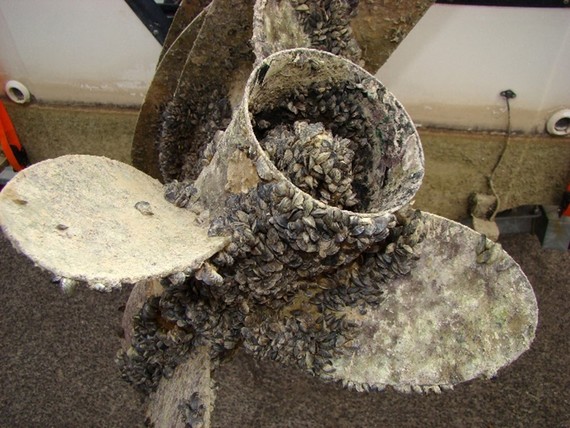 Wild Bulletin, Indiana Department of Natural Resources: As you prepare your boat or recreational equipment to get back on the water this spring, remember to look for aquatic hitchhikers. Zebra mussels, aquatic plants like Eurasian watermilfoil or starry stonewort, and many other invasive species continue to be a threat to Indiana’s waters by degrading fish habitat and negatively affecting recreational boating and fishing. The most common locations where plants, mussels, and animals hitch a ride include:
Wild Bulletin, Indiana Department of Natural Resources: As you prepare your boat or recreational equipment to get back on the water this spring, remember to look for aquatic hitchhikers. Zebra mussels, aquatic plants like Eurasian watermilfoil or starry stonewort, and many other invasive species continue to be a threat to Indiana’s waters by degrading fish habitat and negatively affecting recreational boating and fishing. The most common locations where plants, mussels, and animals hitch a ride include:
- Transom well near the drain plug
- Axle of the trailer
- Lower unit and propeller on the boat motor
- The rollers and bunks that guide the boat onto the trailer
- Anchor and lines
- Bait bucket and live well
Boat owners are asked to drain water from bait buckets, live wells, and boats before leaving the boat landing; leave drain plugs out while travelling on land; clean and dry anything that came in contact with water; and dispose of unwanted bait in the trash. Learn more about aquatic invasive species and how to prevent their movement.
Learn how to stop aquatic hitchhikers.
Find more information about aquatic invasive plants and aquatic invasive invertebrates. Subscribe and receive the Wild Bulletin, Indiana Department of Natural Resources.
Resources:
Invasive plants: Impact on Environment and People, Purdue Extension – Forestry and Natural Resources (FNR)
Report Invasive Species, Purdue Invasive Species
The GLEDN Phone App – Great Lakes Early Detection Network
EDDMaps – Early Detection and Distribution Mapping System
Indiana Department of Natural Resources: Invasive Species
Indiana Invasive Species Council
Cooperative Invasive Species Management Area (CISMA)
Aquatic Invasive Species in the Great Lakes: The Quagga Mussel, Purdue Extension – FNR
Lampreys, Indiana Division of Fish and Wildlife’s Animal Informational Series
Aquatic Invaders in the Marketplace, Illinois-Indiana Sea Grant (IISG)
Great Lakes Sea Grant Network (GLERL), NOAA – Great Lakes Environmental Research Laboratory
Purdue Researchers Get to the Bottom of Another Quagga Mussel Impact, Illinois-Indiana Sea Grant (IISG)
Protect Your Waters, U.S. Fish and Wildlife Service & U.S. Coast Guard
Nongame and Endangered Wildlife, Indiana Department of Natural Resources
Indiana Department of Natural Resources
Recent Posts
- Spotted Lanternflies on the Move! – Purdue Landscape Report
Posted: July 30, 2024 in Forestry, Invasive Animal Species, Invasive Insects, Wildlife, Woodlands - Look Out for Invasive Carp in Your Bait Bucket – Wild Bulletin
Posted: March 31, 2024 in Alert, Aquaculture/Fish, Aquatic/Aquaculture Resources, Invasive Animal Species, Wildlife - State of Indiana Proclamation-Invasive Species Week 2024
Posted: February 19, 2024 in Alert, Forestry, Forests and Street Trees, Invasive Animal Species, Invasive Insects, Invasive Plant Species, Urban Forestry, Wildlife, Woodlands - Invasive Carp Removal on the Ohio River, Wild Bulletin
Posted: December 8, 2023 in Alert, Aquaculture/Fish, Aquatic/Aquaculture Resources, Invasive Animal Species, Wildlife - Join the fight: Help Stop Aquatic Invasive Species – MyDNR
Posted: July 14, 2023 in Alert, Aquaculture/Fish, Aquatic/Aquaculture Resources, How To, Invasive Animal Species, Wildlife - Summer Bat Roost Monitoring Project – MyDNR
Posted: May 8, 2023 in Alert, How To, Invasive Animal Species, Wildlife - Aquatic Invasive Species-Wild Bulletin
Posted: July 14, 2022 in Aquaculture/Fish, Aquatic/Aquaculture Resources, How To, Invasive Animal Species, Wildlife - New Video Series Highlights Great Lakes Areas of Concern-IISG
Posted: July 7, 2022 in Aquaculture/Fish, Aquatic/Aquaculture Resources, Great Lakes, Invasive Animal Species, Wildlife - Cuban Treefrog Identified in Indiana
Posted: June 24, 2022 in Invasive Animal Species, Wildlife - Prevent the Spread of Aquatic Invasive Species, Wild Bulletin
Posted: April 28, 2022 in Aquaculture/Fish, Aquatic/Aquaculture Resources, Invasive Animal Species, Invasive Insects, Invasive Plant Species, Wildlife
Archives
Categories
- Alert
- Aquaculture/Fish
- Aquatic/Aquaculture Resources
- Ask the Expert
- Christmas Trees
- Community Development
- Disease
- Drought
- Forestry
- Forests and Street Trees
- Gardening
- Got Nature for Kids
- Great Lakes
- How To
- Invasive Animal Species
- Invasive Insects
- Invasive Plant Species
- Land Use
- Natural Resource Planning
- Nature of Teaching
- Plants
- Podcasts
- Ponds
- Publication
- Safety
- Spiders
- Timber Marketing
- Uncategorized
- Urban Forestry
- Webinar
- Wildlife
- Wood Products/Manufacturing
- Woodland Management Moment
- Woodlands
